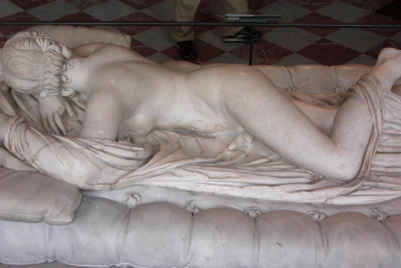The most intriguing part of our discussion last class was the idea of art having an effect on the body and our bodily interactions with the landscape. The question that I am interested in is, was this the intention of the artist or does this serve an entirely different function altogether? With the example of the early decipherers of cuneiform, who positioned themselves in various precaurious positions to copy the inscriptions on rocks and monuments, we briefly touched upon who the intended audience was for such compositions. There are many salient examples of how the body is meant to interact whether consciously or not with a piece of art or architecture but are these the primary reasons for putting something on a high cliff or atop a monumental statue? I was also reminded of several instances in my travels that I have used my body to view, admire, or otherwise achieve a certain effect from a work of art.
In Egypt, while I was visiting the pyramids at Giza I very consciously used my body to interact with the landscape for several pictures. In one picture, my tour guide and camel leader took me to a "prime pyramid photographing position" where I could see all seven of the pyramids in a line and I could pose for pictures. In the picture I have included, my guide, knowing full well how it would look in the picture, positioned me to pose in a certain way where I was essentially "capturing" a pyramid with my hand. One of my friends also did a very cool photo where he was "walking" up the steps of the Step Pyramid at Saqqara and my other friends decided to mimic all the poses of the pharaohs and gods they took pictures in front of. One very interesting example of art determining our bodily positions is when we were at the Temple of Hathor at Dendera and to fully observe the painting of the constellations located on the ceiling, we had to actually lie down on the floor to accomplish it.
I also recall how whenever I visit a temple in Greece, I am often tempted to pose in the front of the monument right in the center, so, of course, it looks nice on camera. Some of the most striking examples to me on how art moves a person are sculptures from the Hellenistic period that actually require a viewer to move completely around it to fully comprehend what is being depicted. For example, on viewing the Sleeping Hermaphroditus from one side, you would simply think you are looking at a nude woman, but upon moving to the other side, you realize that this person has both male and female sex organs. You would not actually know this unless you walked around the figure, rather than observing it from only one angle. Other examples of directing focus can be seen in Rome with the Pantheon, where tourists generally like to stand in the middle of the rotunda to take their pictures.
It certainly wasn't the ancient people's intent that we make funny poses or suspend ourselves off the ground to read the script, but with an example such as the Sleeping Hermaphroditus it was the artist's desire for the viewer to fully engage his body with the art. Many pieces of art do physically move you, as with the ceiling constellation at the Temple of Dendera and the rather uncermonious way one had to see it. Many temples and great monuments were designed with specific focal points that the attention of the viewer was directed to, and often one had to move to certain locations to admire it. Others have inspired viewers to come up with creative new ways to use their body to represent the image in the visual media, such as placing your hand atop a pyramid or walking up its steps. Art it appears, does have the ability to not only move you emotionally, but physically as well.
 Capturing a pyramid at Giza
Capturing a pyramid at Giza
 The Sleeping Hermaphroditus at the Louvre
The Sleeping Hermaphroditus at the Louvre
